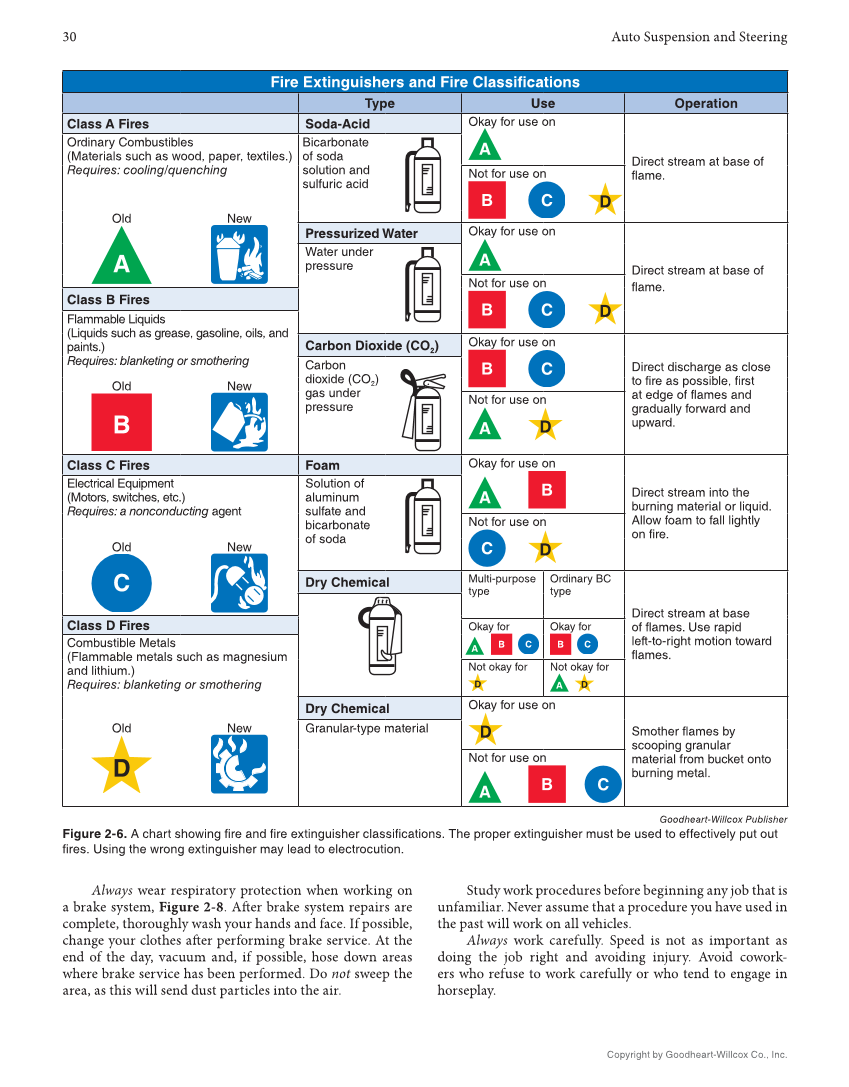30 Auto Suspension and Steering Copyright by Goodheart-Willcox Co., Inc. Always wear respiratory protection when working on a brake system, Figure 2-8. Aft er brake system repairs are complete, thoroughly wash your hands and face. If possible, change your clothes aft er performing brake service. At the end of the day, vacuum and, if possible, hose down areas where brake service has been performed. Do not sweep the area, as this will send dust particles into the air. Study work procedures before beginning any job that is unfamiliar. Never assume that a procedure you have used in the past will work on all vehicles. Always work carefully. Speed is not as important as doing the job right and avoiding injury. Avoid cowork- ers who refuse to work carefully or who tend to engage in horseplay. Goodheart-Willcox Publisher Figure 2-6. A chart showing fire and fire extinguisher classifications. The proper extinguisher must be used to effectively put out fires. Using the wrong extinguisher may lead to electrocution. Fire Extinguishers and Fire Classifications Type Use Operation Class A Fires Soda-Acid Okay for use on A Direct stream at base of flame. Ordinary Combustibles (Materials such as wood, paper, textiles.) Requires: cooling/quenching Bicarbonate of soda solution and sulfuric acid Not for use on B C D Old A New Pressurized Water Okay for use on A Direct stream at base of flame. Water under pressure Not for use on B C D Class B Fires Flammable Liquids (Liquids such as grease, gasoline, oils, and paints.) Requires: blanketing or smothering Carbon Dioxide (CO2) Okay for use on B C Direct discharge as close to fire as possible, first at edge of flames and gradually forward and upward. Carbon dioxide (CO2) gas under pressure Old B New Not for use on A D Class C Fires Foam Okay for use on A B Direct stream into the burning material or liquid. Allow foam to fall lightly on fire. Electrical Equipment (Motors, switches, etc.) Requires: a nonconducting agent Solution of aluminum sulfate and bicarbonate of soda Not for use on C D Old C New Dry Chemical Multi-purpose type Ordinary BC type Direct stream at base of flames. Use rapid left-to-right motion toward flames. Class D Fires Okay for C A B Okay for C B Combustible Metals (Flammable metals such as magnesium and lithium.) Requires: blanketing or smothering Not okay for D Not okay for A D Dry Chemical Okay for use on D Smother flames by scooping granular material from bucket onto burning metal. Old D New Granular-type material Not for use on C A B
